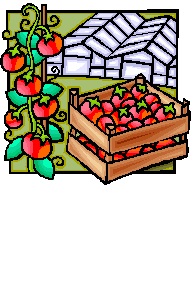 Hoophouses Extend Growing Season - March 6, 2013 Jeff Schalau, Agent, Agriculture & Natural Resources University of Arizona Cooperative Extension, Yavapai County Hoophouses are low tech, greenhouse-like structures that can be used for starting seedlings and for growing vegetables. A hoophouse significantly extends the spring and fall growing seasons while also increasing air and soil temperatures for increased plant growth. They are easily constructed and can last many years. Hoophouse dimensions can be adjusted to fit personal needs and available space. A small hoophouse (sometimes called a low tunnel) may be 4 ft x 10 ft and a larger design (sometimes called a high tunnel) could be 14 to 40 ft x 100 ft or more. Small hoophouses are ideal for small garden beds while larger designs can be built over existing fields. Either way, you can extend your growing season and production with a moderate investment of time, energy, and materials. The most common, inexpensive designs use PVC pipe to support the plastic cover and two end walls that provide access and stability. In Arizona, it is also important to design it so that the sides can be rolled up to provide ventilation during warmer weather. The design I will focus on in this column is 14 ft x 42 ft but is expandable to 100 ft or more in length. It is designed with sidewalls that can be rolled up for additional ventilation and the estimated cost for materials is about $500 - $800. This column will reference a publication from Utah State University that contains a materials list and instructions to build the hoophouse. This publication is linked to the web version of this column. Take care when selecting the hoophouse site as this design is not easily moved. The site should be level and have well-drained soils that are free of serious pathogens and perennial weeds. The site should not be shaded, particularly on the south and west sides. The site also needs to be located near a year-round water source. Tools needed include a circular saw, electric drill, drill bits, sledge hammer, a square, tin snips, and a 1¼? drill bit. While the end walls and doors can be constructed by one person, extra help will be needed to cover the hoophouse with plastic and to help fasten the plastic to the end walls. It is best to begin by building the two ends which are identical and made from lumber. Redwood can be used where the wood will be in contact with the soil. The 1” schedule 40 PVC pipe will create the hoops which should be coated with white exterior latex paint to prevent photodegradation of the plastic. Each hoop is made from a 20 ft length of pipe plus a 28 inch additional section glued together. The additional 28 inches of PVC provides the height to comfortably walk and work inside the hoophouse. Make sure you glue the PVC before you paint. Once the ends are built, a 10 ft x 42 ft area can be staked off and the ends placed and secured to the ground. It is fairly important that the corners be square – this can be checked by measuring from corner to opposite corner crosswise. The PVC hoops are secured to the ground by pounding 24 inch lengths of ½ inch rebar 18 inches into the ground. Gently slide the lengths of PVC over the 6 inches of rebar that remains above ground to place each hoop. The plastic sheeting should be at least 6 mil thick and UV resistant. Have several friends handy to attach the plastic sheeting to one end wall and over the hoops then to the other end wall. Nylon twine is tied to the rebar stakes and run on the outside of the hoophouse for added stability and to keep the plastic taut. The twine should be just loose enough to allow slipping the polyethylene plastic up when raising the sides of the hoophouse for ventilation. This design is for a large hoophouse, but can be scaled down in length to fit smaller areas while using the same ideas. Here, I have left many details out. However, the Utah State Hoophouse Publication provides much greater detail. This is the basic hoophouse design we have included in our Beginning Farmer’s Workshop series that is currently under way in Prescott. I also hope to offer a similar workshop in the Verde Valley next fall. Follow the Backyard Gardener on Twitter – use the link on the BYG website. If you have other gardening questions, call the Master Gardener help line in the Camp Verde office at 928-554-8999 Ext. 3 or e-mail us at cottonwoodmg@yahoo.com and be sure to include your name, address and phone number. Find past Backyard Gardener columns or provide feedback at the Backyard Gardener web site: http://cals.arizona.edu/yavapai/anr/hort/byg/. Additional Resources Constructing a Low-Cost High Tunnel, Utah State University Cooperative Extension, April 2011 http://extension.usu.edu/files/publications/publication/HG_High_Tunnels_2008-01pr.pdf Constructing a Low-Cost High Tunnel - With Photos, Utah State University Cooperative Extension, April 2011 http://extension.usu.edu/files/publications/publication/HG_High_Tunnels_2008-01photos.pdf Temperature Management in High Tunnels, Utah State University Cooperative Extension, April 2010 http://extension.usu.edu/files/publications/publication/Horticulture_HighTunnels_2010-04.pdf |